sympa la page bonzer.
J'ai la chance de surfer un Bonzer shapé par Malcom, c'est un peu ma board préférée
j'ai un octafish de 5'10 , 5 fins
Maitenant ce qui est important je trouve c'est vraiment de preciser que c'est un concept qui peut etre decliné sur different shape ( vois sur le site des campbells) et surfer un bumble bee bien epais en 6'6 doit etre vraiment different de mon octacfish
J'avais initialement acheté un egg en 6'2
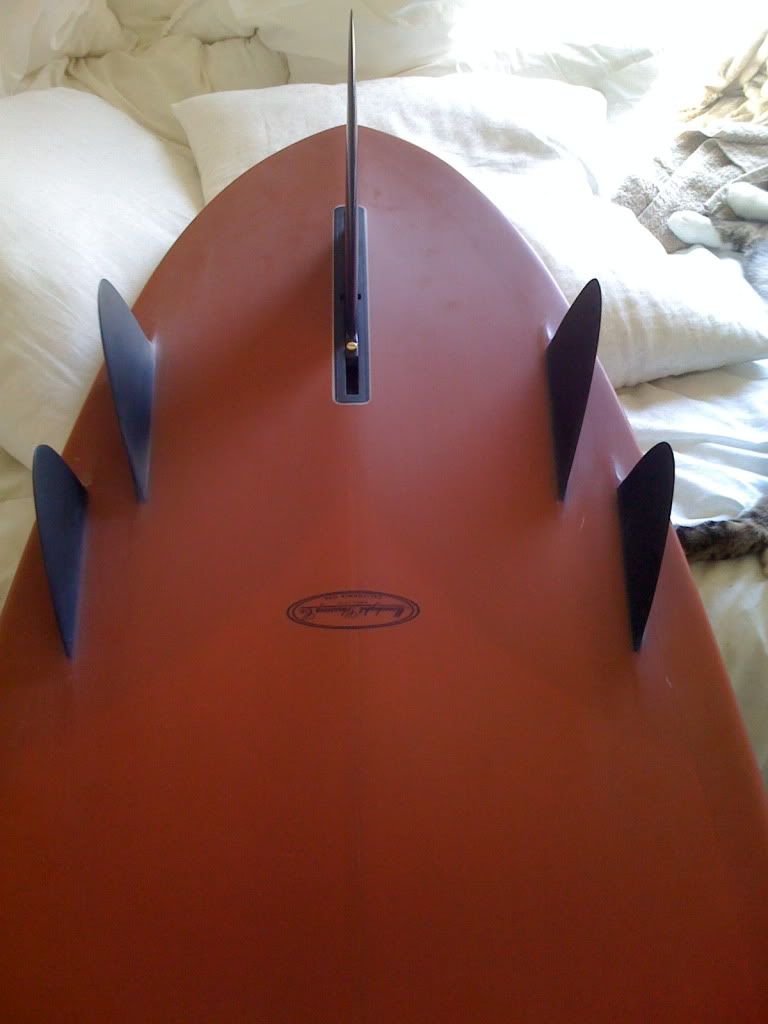
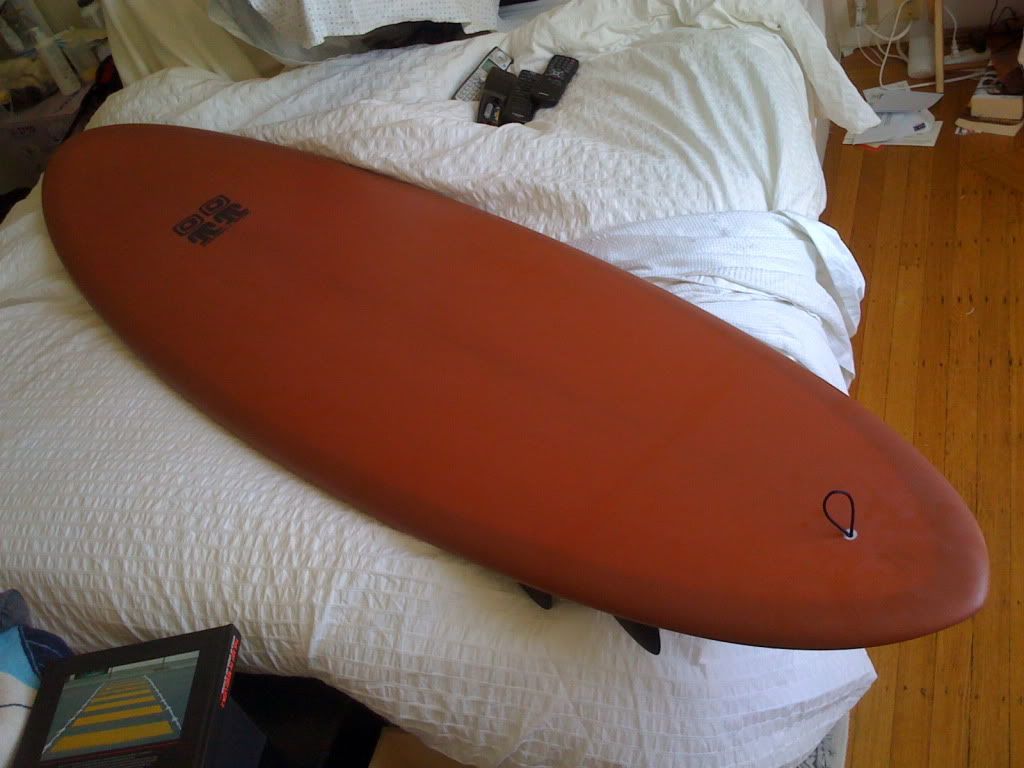
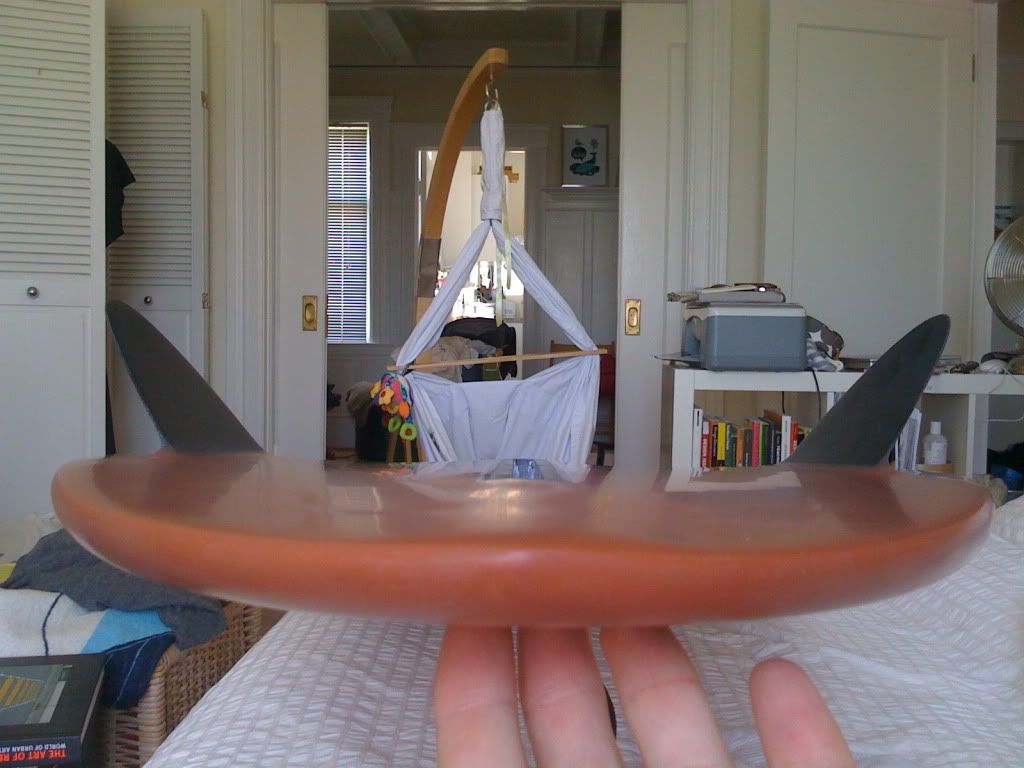
que j'ai change pour ma 5'10.
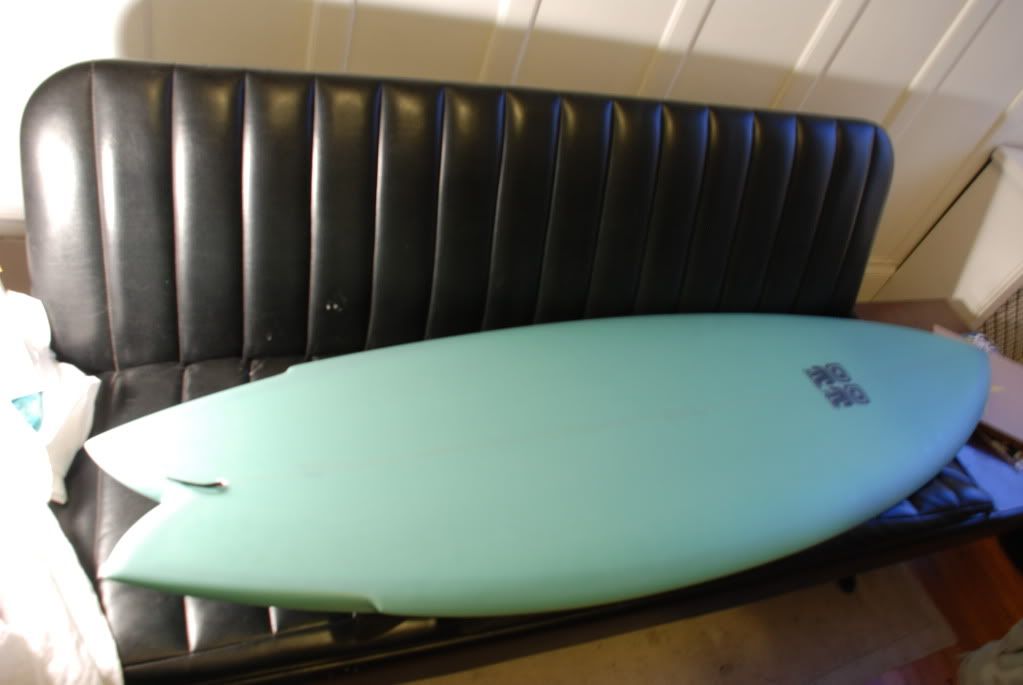
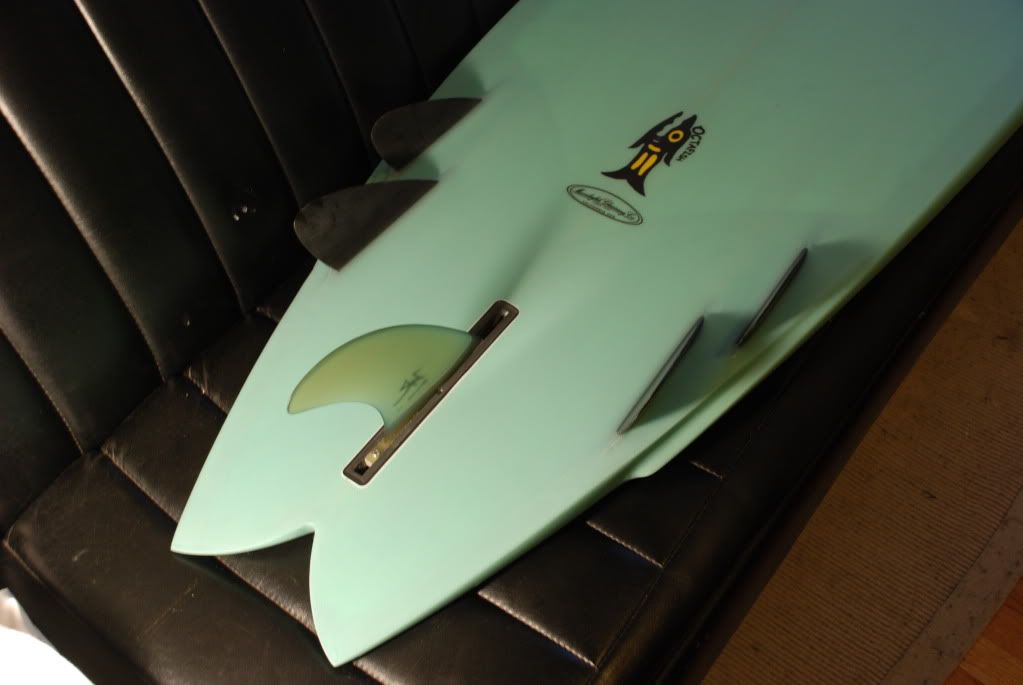
Chaque modele de planche est differente , mais grosso modo je trouve que c'est un peu comme surfer un single fin amelioré
Dans le cas de l'octafish, qui ressemble un peu a un twin retro, ca va tres vite, dans le mur de la vague, avec une super glisse, mais tu n'as pas l'effet un peu loose du twin au bottom et au virage en haut de vague, ca accroche carrement et genere de la vitesse a chaque changement de rail ( effet de compression du double concave , je pense...mais bon je suis pas un pro, je te decris ce que je ressens)
le defaut est que si l'accroche et la vitesse sont vraiment spectaculaire dans une vague creuse et sur un long point break , genre Santa Cruz ici, la planche peut etre un peu "Tracky" comme on dit en anglais , c'est a dire qu'elle a tendance a aller un peu tout droit (effet d'accroche des derives ) c'est pour ca que j'ai changé mon egg , qui boostait bien mais était chiant a tourner et a relancer . En plus il y a un peu de finesse de reglage avec la position de la derive centrale qui change radicalement la sensation et le comportement de la board.
il est de meme pour la taille de la derive centrale
Changer la derive de place de qq centimetres genre de maniere importante le comportement de la planche, donc il faut un peu de temps pour trouver son réglage habituel et sentir l'effet "5e vitesse"
J'adore mon Octafish, tres bon compromis entre vitesse et maniabilité, et dans des grosses vagues (jusqu'a 2 m) meme a 5'10 c'est surprenant car ca part tres vite avec le volume et la sensation dans le mur est geniale.
Le shape du tail est fait tout en finesse avec les decrochements et deux petits channels dans le rail.
Malcom Campbell est un peu shaper/artiste/autiste . il shape quand il veut et pas toujours ce qu'on lui commande
bref il faut attendre 3 mois pour avoir sa board ou avoir a chance de trouver son bonheur dans un des rares shops qui le distribue.
Ce qui est interessant c'est que le concept est rester dans l'ombre pendant longtemps et ressort a fond maintenant avec cette resurgence retro/neo/vintage
pour conclure l'histoire du bonzer je vous mets en copie un article d'honolulu weekly qui traite de l'oublie de ce type de shape et la tentative de "autoappropriation" de Rusty sur le concept bonzer, qui avait trouvé son epilogue dans une competition de surf en Californie
desolé mais c'est en anglais et le titre est "SURFWARS...""" et c'est passionnant
bonne lecture
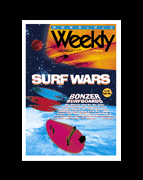
Surf Wars
The Bonzer may be the most revolutionary surfboard you never heard of. Too bad the design got hijacked by guys from the Dark Side.
John Wythe White
June 16, 1999
When you enter Cafe Hale‘iwa from the front door on Kamehameha Highway, look up and you’ll see a pair of strange-looking, well-worn surfboards on display. Both are shortboards that look odd primarily because of their fins. One has a traditional shark-shaped center fin, but two scalene triangles for side fins — sharp-pointed and canted outward rather than rising perpendicular from the surface. The other has an additional triangle fin on each side — a total of five fins. Two deep, concave channels run from the tail of each board between the center and side fins, flattening out about a third of the way toward the nose.
These are "Bonzer" surfboards. If that name doesn’t ring a bell for you, you’re not alone — whether you surf or not. Many surfers have not only never ridden a Bonzer, they’ve never even heard of them.
Too bad, because the Bonzer, originally developed almost 30 years ago, may be the most revolutionary and hydrodynamically functional surfboard ever designed.
There are many reasons why "Bonzer" is not a household word among surfers, but here’s a few of them: the growth in popularity and commercialism of surfing; the formidable forces of American mass production and promotion; and the youthful idealism of two visionary surfers in Oxnard, California.
In 1970, two long-haired brothers from Oxnard designed their first Bonzer, a radical-looking, three-finned, double-concave 6-foot, 2-inch squash-tail. Bonzer is Aussie for "bitchin’" and so were Malcolm and Duncan Campbell, toiling in obscurity within the territorial confines of Ventura County. Unfortunately, this obscurity has followed the Campbell Bros throughout their careers, as many of their innovations have been overlooked and/or attributed to others. …
Surfer (June 1996)
Duncan and Malcolm Campbell started surfing in Santa Monica in 1966, at age 11 and 14, and kept on surfing when their family moved to Oxnard a few years later.
"Shortboards were beginning to replace longboards," says Duncan, "but you couldn’t buy a shortboard yet because only a few shops were making them. So we started hacking away at our longboards and crudely reshaping them. Pretty soon we were buying blanks and shaping our own."
Their father, a photojournalist for Motor Trend and Road & Track magazines, was also, in Duncan’s words, "an inventor in his own right, an intuitive thinker and really into sailboats." Jack Campbell informed his sons that their surfboards were hydrodynamically primitive. He showed them his books on hull design, introduced them to the theories of Bernoulli and started them thinking about how they could apply scientific thought to design a better surfboard.
"In 1970 there were three groups of designer/shapers who were working on the three-fin idea," says Duncan. "Bob McTavish in Australia; Dick Brewer, Reno Abellira and others in Hawai‘i; and my brother and I. But there were two differences between their designs and ours. We were the first to put the two side fins in front of the center fin. All the other three-fin systems prior to ours had the side fins either parallel to the center fin or behind it. Ours is the same fin position that you see today on all Thrusters — the dominant design on contemporary surfboards. In this sense, our Bonzer had the archetypal three-fin system.
"Second, they were experimenting. After a while they all gave up, even began to denounce the design. But we had a vision, based on sound principles, that we knew was going to work. We stayed focused and stuck ***spam*** it. Not only that, but our father made sure we documented everything. We photographed and filmed Bonzers in action, and we published articles in the magazines."
Malcolm and Duncan decided not to patent their design.
"There was a feeling among the magazine editors that this could be a financial opportunity," says Duncan, "and they said, ‘What are you guys going to do about it?’ And we determined, right from the beginning when we published all the dimensions and the technology, that we wanted to give it to whoever wanted to use it. We were in it to advance surfing, not so much for fame and fortune. And we didn’t feel right about taking all the credit. We truly believe that there is no original thought. All we claimed was that we were intuitive enough to combine existing ideas at a particular point in time to produce a superior surfboard design."
The brothers began writing slogans on their Bonzers: "Love Over Gold" or "Always For Love, Never For Money." Says Duncan, "Those were mantras that eventually bit us in the ass. We soon found out that you need a certain amount of commercial success to get your message across. The trick is to participate in the marketplace but not be driven by it, and in that way maintain your integrity."
The Campbell Brothers came to international attention in 1972, when they introduced their highly variant three-finned, concave-tailed Bonzer in the American surfing press. At the time, their crafts seemed strange, almost alien, intruders to both the single-fin and the then "new" twin-fin schools of thought. Even odder than their multifinned forms was their alliance ***spam*** one of the industry giants [Bing Surfboards] to manufacture the boards. Here were two unknown kids from a quietly obscure area, suddenly fronting an approach to surfing and a way of thinking unheard of for a veritable surfboard manufacturing institution. Simply stated, more than a few circuits shorted out. Critical responses ranged from "the breakthrough of the century" to "media hype ... totally unfunctional."
Surfer (October/November 1977)
Understanding that their Bonzer concept would never catch on as long as they remained on the fringes of the surfing industry, Malcolm and Duncan went to Bing Copeland, signed a contract, sold the manufacturing rights to their design and began collecting royalties as Bing Surfboards marketed its version of the Bonzer. The problems began when the manufacturer started cutting corners and altering the design.
"The concaves and fins act as a synergetic system, accelerating water through the channels," says Duncan. "Making it function correctly requires reshaping the concaves — an extra step in production they didn’t want to take. They reduced efficiency to cut costs, and it meant to us that they didn’t care."
Malcolm told a surfing magazine, "We were sitting there watching our design being turned into a total pop-out."
Disillusioned and angry, the brothers wanted out, but they were unable to break the contract.
"We agreed that they could continue to manufacture boards using the Bonzer name," says Duncan, "but we didn’t want the Campbell Brothers name associated ***spam*** them anymore. And we didn’t want any more money from them."
Nevertheless, some damage was done. Bastardized Bonzers began drawing criticism as the corner-cutting modifications interfered ***spam*** the boards’ speed and performance.
One magazine called the Bonzer "a single-fin ***spam*** training wheels." Surfer magazine reported: "It is quite possible that the surrounding furor, big-buck ad campaigns and maybe the times themselves prevented many from ever learning what the design or its inventors were about. The brothers quickly withdrew from their commercial entanglements and retreated to their home grounds."
The design is easy to copy, but for some unknown reason, no one to our knowledge has done it accurately. If any of the variables are changed, the boards become much less effective. ... You must realize that we have spent over five years building, testing, refining and studying the Bonzer. ... It is a synergetic unit. ... Maximum efficiency can only be obtained by using it as such. ... The Bonzer is an entirely different reality in wave riding. ... You must drop all preconceived notions, and approach it ***spam*** an open mind.
"Bonzer Vehicles" by Malcolm and Duncan Campbell
Surfer (August/September 1975)
Despite problems ***spam*** altered designs, the Bonzer enjoyed a growing reputation throughout the ’70s. In 1973, Australian surfer Ian Cairns won the Smirnoff Pro contest at Laniäkea riding a Bonzer. Articles and photos continued to appear in the magazines. Surfing said, "Excellent directional stability and hollow-wave control gave the design a cult following for most of the decade." But Surfer stated, "The last half of the ’70s saw the Bonzer pass from vogue."
The reason for this was one surfer: Mark Richards. He exploded onto the scene riding a twin-fin board six inches shorter than the average shortboard of the day. He rode it beautifully, won contests on it and rose to fame. Soon everyone was riding a twin-fin.
"All of a sudden," says Duncan, "there was a new shortboard revolution, and Bonzers got lost in the mix. But we remained committed to the Bonzer concept. We believed that three-fins were by far the most efficient design, and would in time replace all other designs. We were adamant that the twin-fin was just a novelty."
The Campbells were right, but nobody acknowledged the fact. Instead, another champion surfer appeared on the scene and changed the surfing world again — ***spam*** his own "invention," the world’s "first" three-fin surfboard, the Thruster. He, too, rode it beautifully, won contests on it and rose to fame.
"Lo and behold, three-fins were discovered," says Duncan, "and Simon Anderson was the new Messiah. This was after my brother and I had put 10 years of work into the design and technology of three-fin surfboards, and published dozens of documents on the subject. Simon added a third fin to a twin-fin — he said as much himself. He had no language for it, no system, no science behind it. Ours has a mathematical formula, there’s no guesswork involved. But he was a professional surfer, and by that time surfing had become more commercial, so his name was associated ***spam*** the three-fin forever."
In 1990, a Surfer writer asked how he and his brother felt about Simon Anderson’s getting the credit for three-fins. Malcolm responded, "We had mixed emotions. On one hand, we were glad the tri-fin concept was having an impact throughout the industry at precisely the time we had predicted. At the same time, we were saddened by the fact that the Bonzer was being forgotten and, in some instances, publicly discredited. ... But the biggest disappointment was we couldn’t get anyone to re-examine the Bonzer."
Duncan was upset for additional reasons. The revisionist histories of the surf magazines enraged him, and he sorely regretted that the Campbell brothers were losing an opportunity to communicate ***spam*** a new generation of surfers.
"We kicked and screamed to the magazines," says Duncan. "We said, ‘This is not ethical. You have a responsibility to write history honestly, the way it happened, not the way special-interest groups want it to read. Your magazines are not just entertaining readers, they’re shaping the paradigm of surfing and the minds of young surfers.’ There has to be an education that goes along ***spam*** this process of riding waves in the ocean, the relationship we have to nature, how it changes us physically, mentally and spiritually."
Duncan and Malcolm kept badgering magazine editors and writers. When Australian surf icon Nat Young wrote a history of surfing that excluded the Campbells as inventors of the Bonzer, they threatened legal action — and won. The second printing of the book was revised accordingly. But a glance through back issues of surfing magazines will present a surfing researcher ***spam*** a contradictory history. For example, in 1989, Surfing told "the amazing-but-true story of the three-fin Thruster and how big Simon Anderson’s humble invention radically changed the face of performance surfing — forever." One year later, Surfer stated, "Over a decade before Simon Anderson introduced his revolutionary Thruster in 1980, Duncan and Malcolm Campbell had already produced a functional triangulated-fin system."
"We had hoped to help preserve a heritage," says Duncan, "a more sophisticated and deeper view of surfing. We wanted younger surfers to understand that we are a culture closely connected to the land and sea, not unlike Aborigines, Hawaiians or Indians of North and South America. If we pay attention, we can learn much more from riding waves than just the act itself."
Malcolm continued to shape surfboards in Ventura County. Duncan moved to O‘ahu and opened Cafe Hale‘iwa. Both brothers kept the faith, continuing to build and ride Bonzers, getting others to ride them, making their contributions to the evolution of surfboard design. They built "Thruster Bonzers," adding their concave bottoms to the new tri-fin designs. Surfer reported, "By the late ’80s, interest in the Bonzer renewed as more shapers began experimenting ***spam*** different bottom contours as a way to improve the now-standard tri-fin setup."
In 1982, the brothers tried a new experiment: adding two additional side fins to the Bonzer. And then history repeated itself.
"We developed a five-fin Bonzer that worked so well we believed it could start another revolution in surfboard design," says Duncan. "So we did the same thing we did in 1973. We published the diagrams; we shared the design freely. In 1991, we were approached by the biggest manufacturer in the industry at the time, Rusty Preisendorfer in San Diego. We showed Rusty and his shapers the technology, gave them the templates and demonstrated how to make the boards. Rusty liked the idea, and he promised to give us credit for it. We have pictures of a Campbell Brothers’ five-fin ***spam*** Rusty’s logo on it."
In an era when most designers are looking for an edge, the Campbell brothers have chosen cooperation over competition, freely sharing their concepts in the hope their efforts will help spur board development. ... [Says Malcolm:] "Over the last three years we’ve been sharing our ideas ***spam*** many top shapers and surfers, in the hope this sharing will blast surfboard design out of its prolonged period of stagnation. ... This is just the beginning for the Bonzer five-fin. But, as ***spam*** all potential evolutionary changes, the mind-set must shift. Collaboration between shapers can produce a quantum leap in surfboard design — but the process of evolution comes before ego and self-promotion. We believe this is happening now."
Surfer (September 1990)
In 1997, Duncan was flipping though an issue of Surfing when he saw an article about the five-fin surfboard and how its inventor, Rusty Preisendorfer, had come up ***spam*** the idea. The story went like this: On a fishing trip, Preisendorfer pulled up a tuna and took a close look at its fins and the way they angled out from the body. He experienced an intuitive flash of inspiration, went to his shop and designed a five-fin surfboard ***spam*** a double concave bottom.
"He didn’t mention the collaboration," says Duncan. "But it’s all very simple in the world of paid-editorial journalism: ***spam*** enough of an advertising budget, you can also buy editorial space, and they’ll print whatever you want to say."
$20,000 C-5 SURFER/SHAPER DESIGN CHALLENGEMAY 24 - 28, 1999 AT TRESTLES.Rusty Surfboards’ revolutionary C-5 surfboard design has spurred the C-5 Surfer/Shaper Design Challenge. ... Rusty will award a $20,000 winner-take-all prize to the surfer/shaper team that successfully demonstrates their version of the best-selling C-5 in a competitive environment. ... The architect behind the unique C-5 Design Challenge is company founder Rusty Preisendorfer. Rusty first began developing and experimenting ***spam*** the C-5 design (which features five fins instead of the typical three) in late 1996. The design has since caught on fire in surf shops and is Rusty’s most requested model. ... The innovative C-5 is the first major redesign of the modern shortboard since the early 1980s, when Simon Anderson introduced the three-fin Thruster.
Web site, Rusty Surfboards(January 1999)
When Duncan and Malcolm heard about the contest at Trestles in Southern California, they saw an opportunity for vindication. They would be there, their boards would be ridden and they would attempt to set the record straight in the media. Before the contest, Preisendorfer began to revise his earlier story about the invention of the five-fin surfboard.
"He came out in a trade magazine giving us credit for our work on the design," says Duncan, "along ***spam*** the tuna. But then he went on to say that the Campbell five-fin was good down the line, but hindered turning. That statement is untrue, and everyone who has ridden our boards knows it."
At Trestles, the Bonzer was well represented. Dan Malloy, riding a Campbell Brothers board in five-foot surf, tallied the highest scores on the first day. He had never ridden a Bonzer before. The board he rode was designed for another surfer, Taylor Knox, who broke his foot two weeks before the contest.
Brad Gerlach, riding a cross-logoed Campbell Brothers/Surf Prescriptions by Doc board, won his heat. Joel Tudor, on a Campbell Brothers board, advanced in the same heat. Donovan Frankenreiter, who was supposed to be riding for a shaper named Cordell, ended up using a Bonzer five-fin in his first heat.
"It was the first five-fin we ever made, 15 or 16 years old, a relic off the wall of Cafe Hale‘iwa. We had brought it to the contest. Donovan had ridden it in Hawai‘i and loved it. He saw it and decided to ride it for his heat. He jumped ship to use our board and make a statement, and he placed second."
On the second day, Frankenreiter changed back to his Cordell-shaped board. Malloy and Gerlach won their heats. Tudor didn’t advance. On the third day, however, Malloy made it into the semifinals, but missed the finals by one quarter of a point. The winner of the contest was Jay Larson, Gerlach’s teammate on Doc’s surfboards. Malloy ended up in fifth place.
In the final ceremonies, Preisendorfer began his address ***spam*** an expression of thanks to the Campbell brothers as innovators in the creation of the five-fin surfboard. He invited Malcolm up to the stage; Malcolm thanked Rusty for sponsoring a contest that gave recognition to shapers.
"It was a design victory, if not a financial one," says Duncan. "There was a noticeable difference in the way our boards worked. People saw that they turned well, and that they are not specialized equipment only for hollow waves, glassy waves, or point breaks."
Back in Hale‘iwa, Duncan persists in his quest.
"We’re hoping that ***spam*** this victory, we can get more dialogue going ***spam*** the top people in the industry, let them know there’s a much bigger issue here, making sure that there’s a place for intelligent dialogue," he says. "That’s what we’ve really been doing all these years: working to help make surfing exist in a commercial world and at the same time represent its higher qualities. The hope is that kids who go to the ocean can be healed, can get away from TV commercials, consumerism, hype and egotism."
Cafe Hale‘iwa is Duncan’s forum. His boards are mounted on the restaurant’s walls, and a rotating gallery of framed photos and magazine articles tell the Bonzer’s story. Surfers, shapers and surfing magazine editors come in for breakfast or lunch, and Duncan shares his designs and ideas ***spam*** them. He’s eager (restaurant traffic permitting) to sit down and talk about surfing ***spam*** anyone who’s interested in his philosophies — ***spam*** the metaphysical understanding that the waves we ride are not only water but energy, and that there is joy in merging and communicating ***spam*** waves rather than dominating them.
Meanwhile, up in Oregon on the Columbia River Gorge, short windsurfing boards ***spam*** Bonzer bottoms are selling briskly, performing beautifully and holding their own in races against longer windboards designed solely for speed. Their maker, who goes by the name of "Gorge Animal," is happily paying the Campbell brothers royalties — and giving them full credit for their design.


 )??
)??


